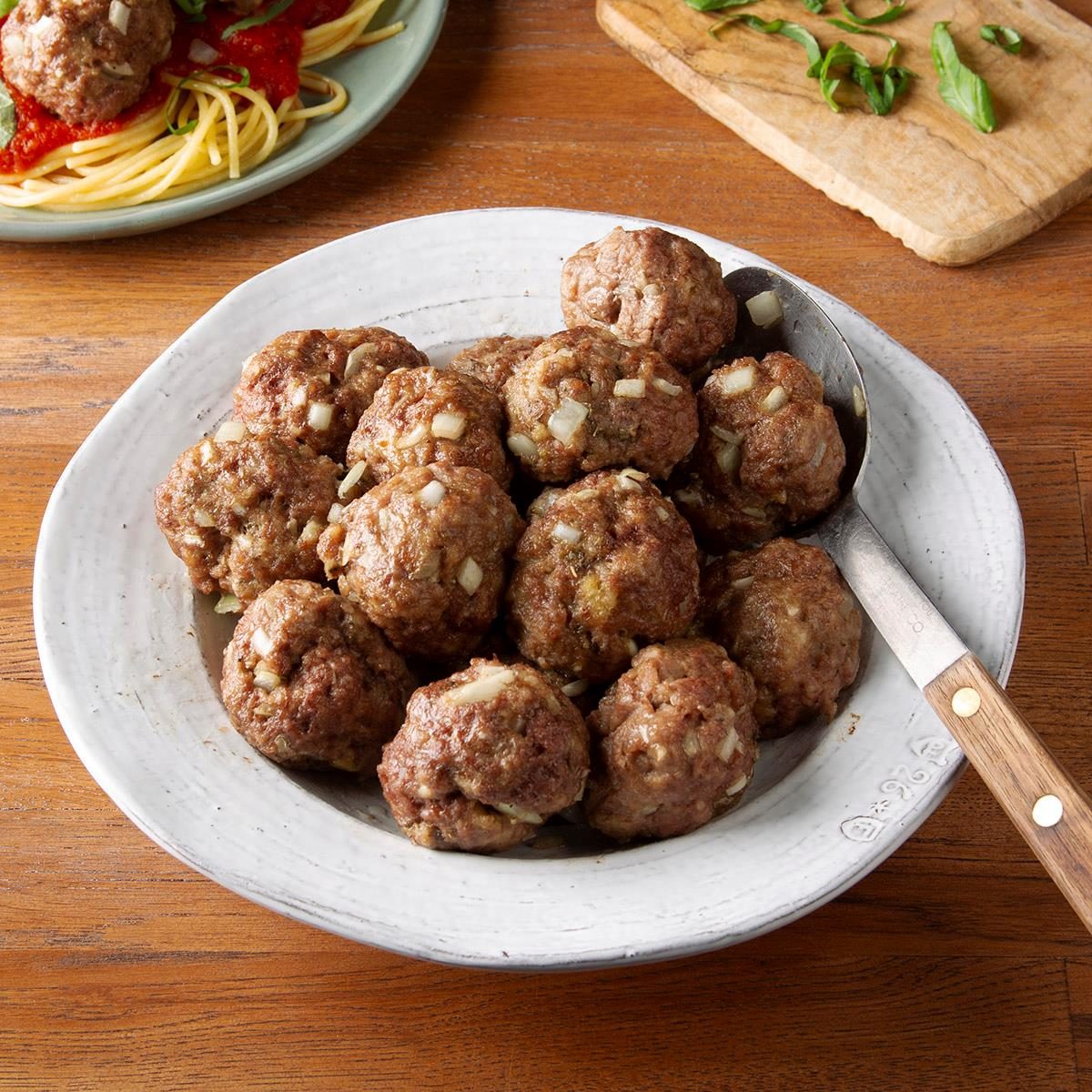Prepare to embark on a culinary journey that will transform you into a meatball maestro! Whether you’re a seasoned chef or a novice cook, this comprehensive guide will provide you with all the essential knowledge and techniques to create succulent and flavorful meatballs that will tantalize your taste buds.
From selecting the perfect ingredients to mastering the art of mixing, forming, and cooking, we’ll explore every aspect of crafting the ultimate meatball. With clear instructions, helpful tips, and creative variations, you’ll discover the secrets to creating meatballs that are not only delicious but also versatile enough to complement any meal or occasion.
Ingredients
Meatballs are a versatile dish that can be made with a variety of ingredients. The most common ingredients include ground meat, bread crumbs, eggs, and seasonings. Ground beef is the most popular type of meat used in meatballs, but other types of ground meat, such as pork, lamb, or turkey, can also be used.
Bread crumbs help to bind the meatballs together and give them a light and fluffy texture. Eggs also help to bind the meatballs together and add moisture. Seasonings, such as salt, pepper, and garlic powder, add flavor to the meatballs.
Alternative Ingredients
In addition to the common ingredients listed above, there are a number of other ingredients that can be added to meatballs to enhance their flavor and texture. These ingredients include:
- Cheese: Grated cheese, such as Parmesan or cheddar, can be added to meatballs to give them a cheesy flavor.
- Vegetables: Finely chopped vegetables, such as onions, carrots, or celery, can be added to meatballs to add moisture and flavor.
- Herbs: Fresh herbs, such as parsley, basil, or oregano, can be added to meatballs to give them a fresh flavor.
- Spices: Spices, such as cumin, chili powder, or paprika, can be added to meatballs to give them a spicy flavor.
Seasoning and Flavoring
Seasoning and flavoring are crucial in elevating the taste of meatballs. A harmonious blend of spices and herbs brings depth and complexity to the dish. It’s important to strike a balance, ensuring that the flavors complement each other without overpowering the meat’s natural taste.
Essential seasonings for meatballs include salt and black pepper, which enhance the savoriness of the meat. Garlic powder and onion powder add a subtle sweetness and depth of flavor. Dried oregano and basil bring a touch of herbaceousness, while paprika adds a hint of smokiness and color.
Creating a Flavorful Blend
To create a flavorful blend, start with a base of salt and pepper. Add garlic powder, onion powder, and dried herbs in equal proportions. Experiment with different ratios to find the balance that suits your taste. Paprika can be added for a touch of smokiness, or chili powder for a hint of heat.
Consider using fresh herbs like parsley or cilantro for a vibrant freshness.
Mixing and Forming
To achieve succulent and flavorful meatballs, proper mixing and forming techniques are crucial. Begin by combining the ground meat, bread crumbs, eggs, and seasonings in a large bowl.
Use your hands to gently mix the ingredients until they are evenly combined. Avoid overmixing, as this can result in tough meatballs. The mixture should have a sticky consistency, not too wet or dry.
Forming Uniform Meatballs
To form uniform meatballs, use a small ice cream scoop or two spoons. Scoop a portion of the mixture and roll it between your palms, shaping it into a ball. Repeat this process until all the mixture has been used.
If the meatballs are too wet, add a little more bread crumbs. If they are too dry, add a little more milk or water. The ideal consistency is slightly moist and firm.
Cooking Methods

Meatballs can be cooked using various methods, each with its advantages and disadvantages. The choice of cooking method depends on the desired texture and doneness of the meatballs.
Pan-Frying
Pan-frying is a popular method for cooking meatballs as it allows for a crispy exterior and a tender interior. Heat a pan over medium heat and add a small amount of oil. Place the meatballs in the pan and cook until browned on all sides.
Reduce the heat to low and continue cooking until the meatballs are cooked through, about 15 minutes.
Baking
Baking is a healthier alternative to pan-frying and results in meatballs that are evenly cooked and moist. Preheat the oven to 375°F (190°C). Line a baking sheet with parchment paper and place the meatballs on the sheet. Bake for 15-20 minutes, or until the meatballs are cooked through.
Simmering
Simmering is a gentle cooking method that results in tender and flavorful meatballs. Place the meatballs in a pot or slow cooker with a flavorful liquid, such as tomato sauce or broth. Bring the liquid to a simmer and cook for 1-2 hours, or until the meatballs are cooked through.
Sauces and Accompaniments
Meatballs are versatile dishes that can be paired with a variety of sauces and accompaniments to enhance their flavor and create a satisfying meal. From classic tomato sauces to creamy mushroom gravies and tangy marinades, the possibilities are endless.
Simple and Flavorful Sauces
One of the most popular sauces for meatballs is a simple tomato sauce. To make a basic tomato sauce, sauté onions and garlic in olive oil until softened. Add crushed tomatoes, oregano, basil, and salt and pepper to taste. Simmer for 20-30 minutes, or until the sauce has thickened.
Another classic option is a creamy mushroom gravy. Sauté mushrooms in butter until golden brown. Add flour and cook for 1 minute. Gradually whisk in milk or cream until the gravy reaches the desired consistency. Season with salt, pepper, and thyme.
Suggested Side Dishes and Accompaniments
Meatballs can be served with a variety of side dishes and accompaniments. Some popular options include mashed potatoes, rice, pasta, or roasted vegetables. To add a touch of freshness, serve meatballs with a side salad or coleslaw. For a more substantial meal, consider pairing meatballs with a side of bread or rolls.
Variations and Adaptations
The simple meatball recipe offers a versatile base for experimentation and customization. Let’s explore some creative variations and adaptations:
Different Meats
* Swap ground beef for ground pork, lamb, veal, or a combination of meats.
- Consider using game meats like venison or elk for a unique flavor.
- Incorporate seafood, such as crab, shrimp, or fish, into the meatballs for a coastal twist.
Vegetables and Cheese
* Add grated vegetables like carrots, zucchini, or onions for texture and nutrition.
- Stir in crumbled feta, Parmesan, or mozzarella cheese for a cheesy delight.
- Use sun-dried tomatoes or roasted peppers for a burst of flavor.
Vegetarian Version
* Replace meat with lentils, beans, or tofu for a plant-based alternative.
Season with a blend of spices and herbs to create a flavorful vegetarian meatball.
Dietary Adaptations
* Make gluten-free meatballs by using gluten-free breadcrumbs or almond flour.
- For low-carb options, use almond flour or crushed pork rinds instead of breadcrumbs.
- Consider using dairy-free cheese or milk alternatives for those with lactose intolerance.
Creative Ideas
* Create spicy meatballs by adding chili powder, cayenne pepper, or sriracha.
- Experiment with Asian flavors by incorporating soy sauce, ginger, and sesame oil.
- For a sweet and tangy twist, add pineapple chunks and a touch of honey.
Presentation and Serving
The presentation of meatballs can elevate their appeal and make them a memorable dish. Here are some tips for arranging and presenting meatballs:
Arranging and Presenting
- Arrange meatballs in a shallow dish or on a platter, ensuring they do not overlap.
- Use a variety of colors and textures to create a visually appealing dish. For instance, add green herbs or colorful vegetables.
- Consider using skewers to present meatballs as appetizers or finger food.
- Create height by placing meatballs on a bed of mashed potatoes or rice.
Garnishes and Accompaniments
Garnishes and accompaniments can enhance the presentation and flavor of meatballs:
- Sprinkle fresh herbs such as parsley, cilantro, or basil over the meatballs.
- Add grated Parmesan cheese or crumbled feta for a salty touch.
- Serve with a dollop of sour cream or yogurt for a creamy contrast.
- Accompany meatballs with crusty bread or crackers for dipping.
Creative Serving Ideas
Think beyond traditional serving styles to create memorable presentations:
- Use a mini waffle maker to create meatball waffles.
- Skewer meatballs and grill them for a smoky flavor.
- Stuff meatballs into hollowed-out bell peppers or zucchini.
- Create a meatball sub by placing meatballs on a hoagie roll with your favorite toppings.
Conclusion

As you delve into this guide, you’ll gain the confidence to experiment with different flavors, techniques, and presentations. Whether you prefer classic Italian meatballs simmering in a rich tomato sauce or innovative vegetarian versions bursting with vegetables, the possibilities are endless.
So gather your ingredients, fire up your stove, and let’s embark on this culinary adventure together. Prepare to savor the joy of creating and enjoying homemade meatballs that will become a staple in your kitchen repertoire.
Answers to Common Questions
What is the secret to making tender and juicy meatballs?
The key to tender meatballs lies in the ratio of meat to breadcrumbs and the addition of moisture. Use a combination of ground meat (beef, pork, or a blend) and breadcrumbs to absorb excess moisture, and add an egg and some milk or broth to provide moisture and bind the ingredients together.
How do I prevent my meatballs from falling apart?
To ensure your meatballs stay intact, handle them gently when mixing and forming. Avoid overworking the mixture, as this can toughen the meatballs. Additionally, make sure to brown the meatballs thoroughly before simmering them in a sauce, as this will help seal in the juices.
What are some creative variations I can try with my meatballs?
Experiment with different meats, such as lamb, turkey, or a combination of meats. Add vegetables like grated zucchini, carrots, or bell peppers for extra flavor and texture. You can also incorporate cheese, herbs, or spices to create unique and flavorful meatballs.
